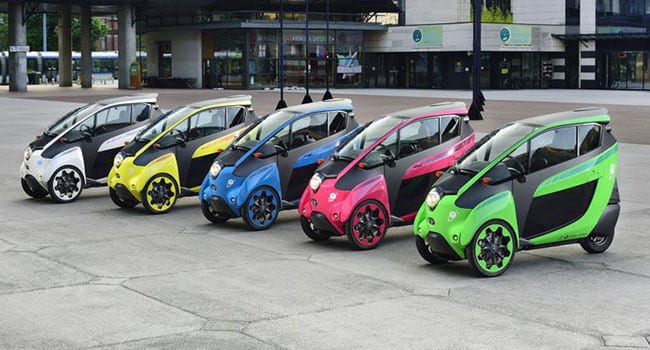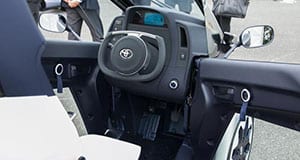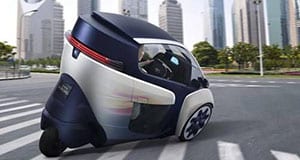
The i-Road has been put into production by Toyota, in very limited numbers, and has been tested around the world. A battery pack feeds an electric motor that drives the rear wheel. The range is about 50 km, it has a top speed of 45 to 50 km/h and features surprisingly nimble performance
 There’s no shortage of alternate forms of personal transportation these days.
There’s no shortage of alternate forms of personal transportation these days.
Manufacturers from every corner of the industrial sector are on a never-ending quest to come up with a workable alternative to the automobile as we know it.
They come in all shapes and sizes, from battery-powered skateboards, to hover boards, to the remarkable but stillborn Segway, to increasingly popular electrified bicycles.
One of the more usable and practical contraptions making the rounds is Toyota’s “Personal Mobility Vehicle,” the i-Road.
Unlike the vast majority of these efforts, the i-Road has actually been put into production (albeit in very limited numbers) and has been tested in cities around the world.
It’s also one of the few non-car alternatives I’ve actually had the chance to spend some time in. And, I’ve got to say, it’s one of the most entertaining vehicles I’ve ever driven.
Part motorcycle and part automobile, the three-wheeled i-Road is unique in that it has an active front suspension that allows the occupants to tilt the vehicle through corners like a motorcycle, while being fully enclosed and weather-tight.
A lithium-ion battery pack feeds an electric motor that drives the rear wheel and the range is about 50 km. The i-Road has a top speed of 45 to 50 km/h and features surprisingly nimble performance.

When the driver turns the steering wheel, a computer seamlessly calculates the lean angle required to navigate the turn. There are two doors and two motorcycle-style seats, but there’s no heating or air conditioning, nor storage
But what really distinguishes it is the front suspension. A “central turning point” in the front of the vehicle connects to a rotary gear and linkage that runs across the front of the i-Road. When the driver turns the steering wheel, a computer control unit calculates how much force is needed to move the vehicle forward and what kind of lean angle is required to navigate turns. It all happens in nano-seconds and it’s almost completely smooth and seamless.
The i-Road can handle up to 26 degrees of lean angle and, at first it feels like you’re about to fall over, that this weird collection of bits and pieces can’t possibly handle tight turns at any kind of speed. But it does – and the vehicle remains stable, smooth and perfectly level.
At rest, it’s upright and the vehicle’s brakes change the body stance as well as slowing the i-Road down if you come into a turn a little too hot.
This vehicle is not wonky or strange to operate.
There are two doors, two seats – motorcycle style – and you simply get in, close the door, hit the power button and off you go.
Unlike just about every alternate mode of transportation I’ve ever driven, the i-Road is neither peculiar nor boring. That said, creature comforts are absent – there is no heating or air conditioning, nor storage.
So aside from its high fun factor, the i-Road isn’t something you want to spend a huge amount of time in.
Will it be for sale in Canada?
Toyota says it has absolutely no plans to put the i-Road on the market here. But the company did provide a small number of i-Roads for a ride-share program in Grenoble, France, and has not categorically said “No.”

Part motorcycle and part automobile, the three-wheeled Toyota i-Road is unique in that it has an active front suspension that allows the occupants to tilt the vehicle through corners like a motorcycle, while being fully enclosed and weather-tight
Were Toyota to contemplate marketing this intriguing little runabout in Canada, one of its biggest hurdles would be overcoming the bureaucracy and recalcitrance of Transport Canada. Unless it has to do with safety, this arm of the government doesn’t take kindly to innovation and many a good idea has ended up in the round file at Transport Canada.
The Segway, for example, went nowhere. It’s actually illegal to operate one on Canadian streets and it has wound up in the same vehicle classification as a fork lift.
If we’re serious about alternate transportation, one of the first things that needs doing is an audit of Transport Canada.
Ted Laturnus writes for Troy Media’s Driver Seat Associate website. An automotive journalist since 1976, he has been named Canadian Automotive Journalist of the Year twice and is past-president of the Automotive Journalists Association of Canada (AJAC).
The views, opinions and positions expressed by columnists and contributors are the author’s alone. They do not inherently or expressly reflect the views, opinions and/or positions of our publication.

